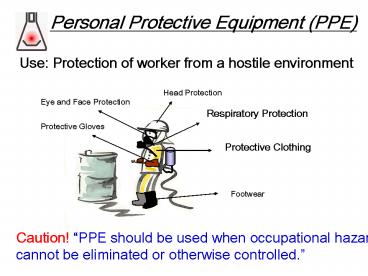Personal Protective Equipment PPE - PowerPoint PPT Presentation
1 / 12
Title:
Personal Protective Equipment PPE
Description:
Components: Face piece, Filter/Sorbent cartridge. Exhalation valve ... Cartridge available * Advantage - Light weight and inexpensive. Protective Clothing ... – PowerPoint PPT presentation
Number of Views:201
Avg rating:3.0/5.0
Title: Personal Protective Equipment PPE
1
Personal Protective Equipment (PPE)
Use Protection of worker from a hostile
environment
Head Protection
Eye and Face Protection
Respiratory Protection
Protective Gloves
Protective Clothing
Footwear
Caution! PPE should be used when occupational
hazards cannot be eliminated or otherwise
controlled.
2
Respiratory Protection
The most common route of entry for hazardous
materials in the industrial and chemical spill
environments Forms of hazard Vapors and gases,
dusts, fibers, fumes, and mists Types of
Respirators Air Purifying and Air
Supplied SCBA Self Contained Breathing
Apparatus Fully self contained
Components - Face piece - Breathing tube -
Regulator - Air cylinder
3
Respiratory Protection
SCBA Self Contained Breathing Apparatus
Offers enhanced mobility, highest protection
Limited by time constraints i.e. 60 minutes
cylinder Maintain 1,000 X TLV Concerns when
worn outside a Level B chemical resistant suits,
all components of the breathing device are
exposed to chemical Atmosphere or product
4
Respiratory Protection
SAR Supplied Air Respirator Lighter than a
SCBA Indefinite time limit as the air supply
if from a remote source Limited by route of
travel i.e. dragging hose behind wearer
Exposure of hose and fittings is one more
compatibility to be considered Understandabl
y sharp edges or closing doors would affect air
supply
5
Respiratory Protection
APR Air Purifying Respirator Components
Face piece, Filter/Sorbent cartridge
Exhalation valve Maintain 50 X TLV(full face),
10 X TLV(half face) Limits - Sufficient
O2 - Known contaminants - Known
concentration - Below IDLH - Good odor
warning properties - Cartridge available
Advantage - Light weight and inexpensive
6
Protective Clothing
One of the most important BUZZ words with
regards to Protective clothing is
compatibility. There is NO superman outfits when
responding to a hazardous Material spill.
Therefore we must clearly understand how well
our protective clothing of choice withstands the
known contaminant. Effects on PPE How
chemicals may destroy our protection?
Permeation Penetration Degradation
7
Protective Clothing
Effects on PPE
Permeation The movement of a chemical through
the PPE on a molecular level. There is typically
no visible means of initial detection of
permeation. Penetration The movement of a
chemical through an opening in the PPE. This
opening may be a pin hole, through stitch holes,
an unclosed zipper, or physical damage to a
suit. Degradation The action of the chemical on
a suit resulting in physical change to the suit
structure, fabric or components may become
brittle, discolor stretch, shrink or decay.
8
Protective Clothing
Effects on PPE
Limiting exposure contact time The less time a
vapor or liquid contacts the suit, the better
the chance of resisting breakthrough. Avoid
puddles and direct splash whenever
possible. Lowering exposure concentration
Aggressively using positive pressure
ventilation or utilizing natural wind direction
to reduce airborne concentrations benefits the
suit wearer.
Consider not entering areas where risks exceed
chemical contact. Explosive forces, flashovers,
and full chemical submersions are not areas of
risks that PPE is designed to protect against. A
NO GO option or altering the risks must be
considered.
9
Level of PPE
Level A This is the highest level of skin
and respiratory protection. The ensemble
includes a fully encapsulating vapor
protective chemical resistant suit, and a
pressure-demand SCBA or SAR. Other items
include inner and outer gloves, head
protection, communications, resistant boots.
10
Level of PPE
Level B This maintains the highest level
of respiratory protection, but has a lower
level of skin protection. This ensemble includes
a pressure- demand SCBA or SAR and
an encapsulating or non-encapsulating splash
protective chemical resistant suit, other
items included are similar to Level A.
11
Level of PPE
Level C This offers the same level of skin
protection as level B, but lessens the
respiratory protection. This ensemble utilizes a
splash protective chemical resistive suit, an
APR and other items similar to previous levels.
12
Level of PPE
Level D This level offers no respiratory
protection and minimal skin protection.
Typically, this may consist of hard hat, safety
glasses, coveralls or apron, safety boots, etc.






























